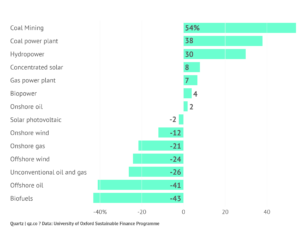Executive Summary

The cost of capital is a key lever in the real economy, due to its ability to influence capital flows and investment decisions. This report seeks to understand how financing costs across different energy technologies and markets has changed over the last twenty years. It forms the first output of the Energy Transition Risk and Cost of Capital Project (ETRC) initiated by the Oxford Sustainable Finance Programme.
In addition to tracking changes in the cost of capital across the energy sector, over multiple years ETRC will seek to understand what is driving changes in the cost of capital, for example, between fossil fuels and renewable energy; what is impeding or enabling the pricing of energy transition risk, for example, data availability and regulation; and how the changing cost of capital will impact companies and providers of finance and investment, for example, through changing the economic and financial returns available across the energy sector. Research in these areas is essential for, among other things, identifying transformational interventions that can shift capital flows towards clean energy and away from dirty energy. It will also provide insights for shifting capital flows in other sectors of the global economy as part of the net zero carbon transition.
In our first report, we track how the cost of debt for fossil fuels and renewables have changed internationally over the past 20 years. We examine financing costs by analysing syndicated bank loan spreads taken from LPC DealScan. The sample from LPC DealScan includes loan information on 12,072 loan deals between 2000 and 2020, involving 5,033 borrowers across 118 countries in the energy and electric utilities sectors as identified by The Refinitiv Business Classification (TRBC)1 sector classification. The TRBC classifications are widely used by both academics and market practitioners.
While climate-related transition risks in the energy sector are sometimes viewed as distant, long-term risks, the impacts of which will not be felt for decades to come, we find this does not reflect reality. A summary of our key findings is detailed below.
1 TRBC was originally developed by the Reuters Group and has been owned by Refinitive since 2018. It is the basis for Refinitive Indices. Following the TRBC sector classification, the energy production sector is defined as the production of both fossil fuels, as well as the production of renewable fuels, such as biofuels, and the supply of renewable energy equipment. For the electric utilities, we grouped them into two types of electric utilities: power generation and other electric utilities. Within power generation category, we manually identify renewable (solar PV and CSP, offshore and onshore wind, biopower, and hydropower) and fossil fuels (coal-fired and gas-fired) power generation plants
Change in loan spread, 2010-2020

Findings by country/region
Notes: Syndicated bank loan data is taken from Refinitiv LPC DealScan. We use The Refinitiv Business Classification (TRBC) to classify transactions in the energy production and power generation sectors. For energy production, we focus on four industry groups: renewable energy (biofuels and renewable energy services), oil & gas production, oil & gas-related equipment and services, and coal mining. Within the power generation category, we manually identify renewable (solar PV and CSP, offshore and onshore wind, biopower, and hydropower) and fossil fuels (coal-fired and gas-fired) power generation plants. Please download our full report for more in-depth analysis.
